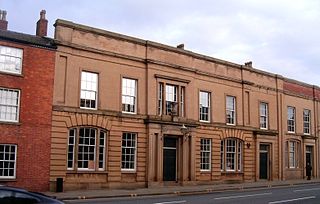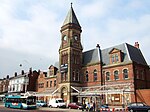
The Liverpool and Manchester Railway (L&MR) was the first inter-city railway in the world. It opened on 15 September 1830 between the Lancashire towns of Liverpool and Manchester in England. It was also the first railway to rely exclusively on locomotives driven by steam power, with no horse-drawn traffic permitted at any time; the first to be entirely double track throughout its length; the first to have a true signalling system; the first to be fully timetabled; and the first to carry mail.

Edge Hill is a district of Liverpool, England, south east of the city centre, bordered by Kensington, Wavertree and Toxteth.
The Oldham Branch Railway was an early railway of the Manchester and Leeds Railway Company connecting Oldham to Manchester.

Wapping or Edge Hill Tunnel in Liverpool, England, is a tunnel route from the Edge Hill junction in the east of the city to the Liverpool south end docks formerly used by trains on the Liverpool-Manchester line railway. The tunnel alignment is roughly east to west. The tunnel was designed by George Stephenson with construction between 1826 and 1829 to enable goods services to operate between Liverpool docks and all locations up to Manchester, as part of the Liverpool and Manchester Railway. It was the first transport tunnel in the world to be bored under a city. The tunnel is 2,030 metres (1.26 mi) long, running downhill from the western end of the 262 metres (860 ft) long Cavendish cutting at Edge Hill in the east of the city, to Park Lane Goods Station near Wapping Dock in the west. The Edge Hill portal is near the former Crown Street Station goods yard. The tunnel passes beneath the Merseyrail Northern Line tunnel approximately a quarter of a mile south of Liverpool Central underground station.

Edge Hill railway station is a railway station that serves the district of Edge Hill, Liverpool, England and is one of the oldest railway stations in the world.
The Bolton and Leigh Railway (B&LR) was the first public railway in Lancashire. It opened for goods on 1 August 1828, and thus preceded the Liverpool and Manchester Railway (L&MR) by two years. Passengers were carried from 1831. The railway operated independently until 1845 when it became part of the Grand Junction Railway.
The Warrington and Newton Railway was a short early railway linking Warrington to the Liverpool and Manchester Railway at Newton, and to pits at Haydock, nearby. It opened in 1831.
The North Union Railway was an early British railway company, operating two main routes, from Parkside to Preston and from Bolton Trinity Street to Preston, all in Lancashire. The northerly part of the routes sharing the line from Euxton to Preston.

Broad Green railway station is a railway station serving the Broadgreen district of Liverpool, England, 3+1⁄2 miles (5.6 km) east of Liverpool Lime Street. Established in 1830, it is the world's oldest actively operating railway station. Electrically powered trains have been operating through the station since March 2015, using Class 319 EMUs.

Warrington Central is one of three main railway stations serving the town of Warrington in Cheshire, England. It is located on the southern route of the Liverpool to Manchester Lines, the former Cheshire Lines Committee route between Liverpool and Manchester; the station is situated approximately halfway between the two cities.

Sankey for Penketh railway station, also known as just Sankey, is a railway station in the west of Warrington, Cheshire, England, serving the Great Sankey, Penketh and Whittle Hall areas of the town. The station, and all trains serving it, are operated by Northern Trains. It is designated by English Heritage as a Grade II listed building.

Rainhill railway station serves the district of Rainhill in Merseyside, England. It is situated on the electrified northern route of the Liverpool to Manchester Line, forming part of the Liverpool City Line. The station, and all trains serving it, are operated by Northern Trains on behalf of Merseytravel and are branded as Merseytravel services.

Liverpool Road is a former railway station on the Liverpool and Manchester Railway in Manchester, England; it opened on 15 September 1830. The station was the Manchester terminus of the world's first inter-city passenger railway in which all services were hauled by timetabled steam locomotives. It is the world's oldest surviving terminal railway station. With tracks running at a first floor level behind the building, it could also be considered one of the world's first elevated railway stations.

The Manchester and Bolton Railway was a railway in the historic county of Lancashire, England, connecting Salford to Bolton. It was built by the proprietors of the Manchester, Bolton and Bury Canal Navigation and Railway Company who had in 1831 converted from a canal company. The 10-mile (16 km) long railway was originally to have built upon most of the line of the canal, but it was eventually built alongside the Salford and Bolton arms of the canal. The Act of Parliament also allowed the construction of a connection to Bury, but technical constraints meant that it was never built.
Parkside railway station was an original station on the Liverpool and Manchester Railway. It then became the interchange station between lines when the Wigan Branch Railway opened in 1832, moving to the physical junction of the two lines in 1838. The station continued as an interchange until being by-passed in 1847 when a west curve was opened to facilitate north–south links that did not go through the station. Traffic declined further after the Winwick cut-off opened in 1864 leading to closure in 1878.
Golborne South railway station was one of two stations serving the town of Golborne, to the south of Wigan.

Preston Brook railway station was a station on the Grand Junction Railway serving the villages of Preston Brook and Preston on the Hill in what was then Cheshire, England. It opened on 4 July 1837 when the line opened.
The Wigan Branch Railway was a short-lived early British railway company, formed in 1830 and operating from 1832 to 1834 in Lancashire. It was constructed to link Wigan and the surrounding coalfield to the Liverpool and Manchester Railway (L&MR). It was involved in the first parliamentary approved amalgamation of railways to become part of the North Union Railway. Most of the line eventually became part of the West Coast Main Line (WCML).
The Kenyon and Leigh Junction Railway (K&LJR) was constructed to link the Bolton and Leigh Railway (B&LR), which terminated at the Leigh Branch of the Leeds and Liverpool Canal, with the Liverpool and Manchester Railway (L&MR) at Kenyon.
Wavertree Lane was one of the original stopping-places on the Liverpool & Manchester Railway which opened in 1830. Stopping-places were commonly located at supervised level crossings where gatekeepers were available to signal trains to stop close to the point at which the line crossed the road, in this case Wavertree Lane. The stopping-places were generally primitive in nature without platform or shelter for passengers. Wavertree Lane appeared in the first official list of stopping-places issued in February 1831. The list was probably issued to reduce the number of informal intermediate stops requested by passengers. In the early days only second class trains made such request stops although mixed class trains were introduced subsequently.
















